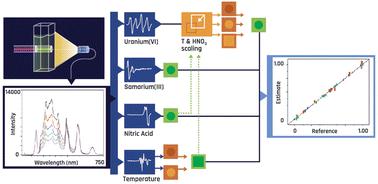Our official English website, www.x-mol.net, welcomes your feedback! (Note: you will need to create a separate account there.)
Simultaneous quantification of uranium(VI), samarium, nitric acid, and temperature with combined ensemble learning, laser fluorescence, and Raman scattering for real-time monitoring
Analyst ( IF 4.2 ) Pub Date : 2022-08-08 , DOI: 10.1039/d2an00998f Luke R Sadergaski 1 , Hunter B Andrews 1
Analyst ( IF 4.2 ) Pub Date : 2022-08-08 , DOI: 10.1039/d2an00998f Luke R Sadergaski 1 , Hunter B Andrews 1
Affiliation

|
Laser-induced fluorescence spectroscopy (LIFS), Raman spectroscopy, and a stacked regression ensemble was developed for near real-time quantification of uranium(VI) (1–100 μg mL−1), samarium (0–200 μg mL−1) and nitric acid (0.1–4 M) with varying temperature (20 °C–45 °C). LIFS applications range from fundamental lab-scale studies to real-time process monitoring at industrial levels, such as nuclear reprocessing applications, provided the phenomena affecting the fluorescence spectrum are accounted for (e.g., absorption, quenching, complexation). Multiple chemometric models were examined and compared to a more traditional multivariate regression approach called partial least squares (PLS). Results obtained on synthetic samples selected using D-optimal experimental design indicated that a stacked regression method, which included ridge regression, random forest, PLS, and an eXtreme gradient boost algorithm, successfully measured uranium(VI) concentrations directly in nitric acid without measuring luminescence lifetimes or standard addition. The top model resulted in percent root-mean-square error of prediction values of 5.2, 1.9, 3.0, and 2.3% for U(VI), Sm3+, HNO3, and temperature, respectively. The approach may be useful for quantifying fluorescent fission products (e.g., Sm3+) to provide information on burnup of irradiated nuclear fuel. This novel framework reinforces the applicability of LIFS for real-time applications in nuclear fuel cycle applications.
中文翻译:

同时量化铀 (VI)、钐、硝酸和温度,并结合集成学习、激光荧光和拉曼散射进行实时监测
开发了激光诱导荧光光谱 (LIFS)、拉曼光谱和堆叠回归集合,用于铀 ( VI ) (1-100 μg mL -1 )、钐 (0-200 μg mL -1 )的近实时定量和不同温度 (20 °C–45 °C) 的硝酸 (0.1–4 M)。LIFS 应用范围从基础实验室规模的研究到工业水平的实时过程监测,例如核后处理应用,只要考虑到影响荧光光谱的现象(例如、吸收、淬灭、络合)。检查了多个化学计量模型,并与称为偏最小二乘法 (PLS) 的更传统的多元回归方法进行了比较。使用 D 最优实验设计选择的合成样品获得的结果表明,堆叠回归方法(包括岭回归、随机森林、PLS 和 eXtreme 梯度提升算法)成功地直接测量了硝酸中的铀 ( VI ) 浓度,而无需测量发光寿命或标准添加。顶级模型导致 U( VI )、Sm 3+、HNO 3的预测值的百分比均方根误差分别为 5.2、1.9、3.0 和 2.3%,和温度,分别。该方法可用于量化荧光裂变产物(例如,Sm 3+)以提供有关辐照核燃料燃耗的信息。这种新颖的框架加强了 LIFS 在核燃料循环应用中的实时应用的适用性。
更新日期:2022-08-12
中文翻译:

同时量化铀 (VI)、钐、硝酸和温度,并结合集成学习、激光荧光和拉曼散射进行实时监测
开发了激光诱导荧光光谱 (LIFS)、拉曼光谱和堆叠回归集合,用于铀 ( VI ) (1-100 μg mL -1 )、钐 (0-200 μg mL -1 )的近实时定量和不同温度 (20 °C–45 °C) 的硝酸 (0.1–4 M)。LIFS 应用范围从基础实验室规模的研究到工业水平的实时过程监测,例如核后处理应用,只要考虑到影响荧光光谱的现象(例如、吸收、淬灭、络合)。检查了多个化学计量模型,并与称为偏最小二乘法 (PLS) 的更传统的多元回归方法进行了比较。使用 D 最优实验设计选择的合成样品获得的结果表明,堆叠回归方法(包括岭回归、随机森林、PLS 和 eXtreme 梯度提升算法)成功地直接测量了硝酸中的铀 ( VI ) 浓度,而无需测量发光寿命或标准添加。顶级模型导致 U( VI )、Sm 3+、HNO 3的预测值的百分比均方根误差分别为 5.2、1.9、3.0 和 2.3%,和温度,分别。该方法可用于量化荧光裂变产物(例如,Sm 3+)以提供有关辐照核燃料燃耗的信息。这种新颖的框架加强了 LIFS 在核燃料循环应用中的实时应用的适用性。



























 京公网安备 11010802027423号
京公网安备 11010802027423号